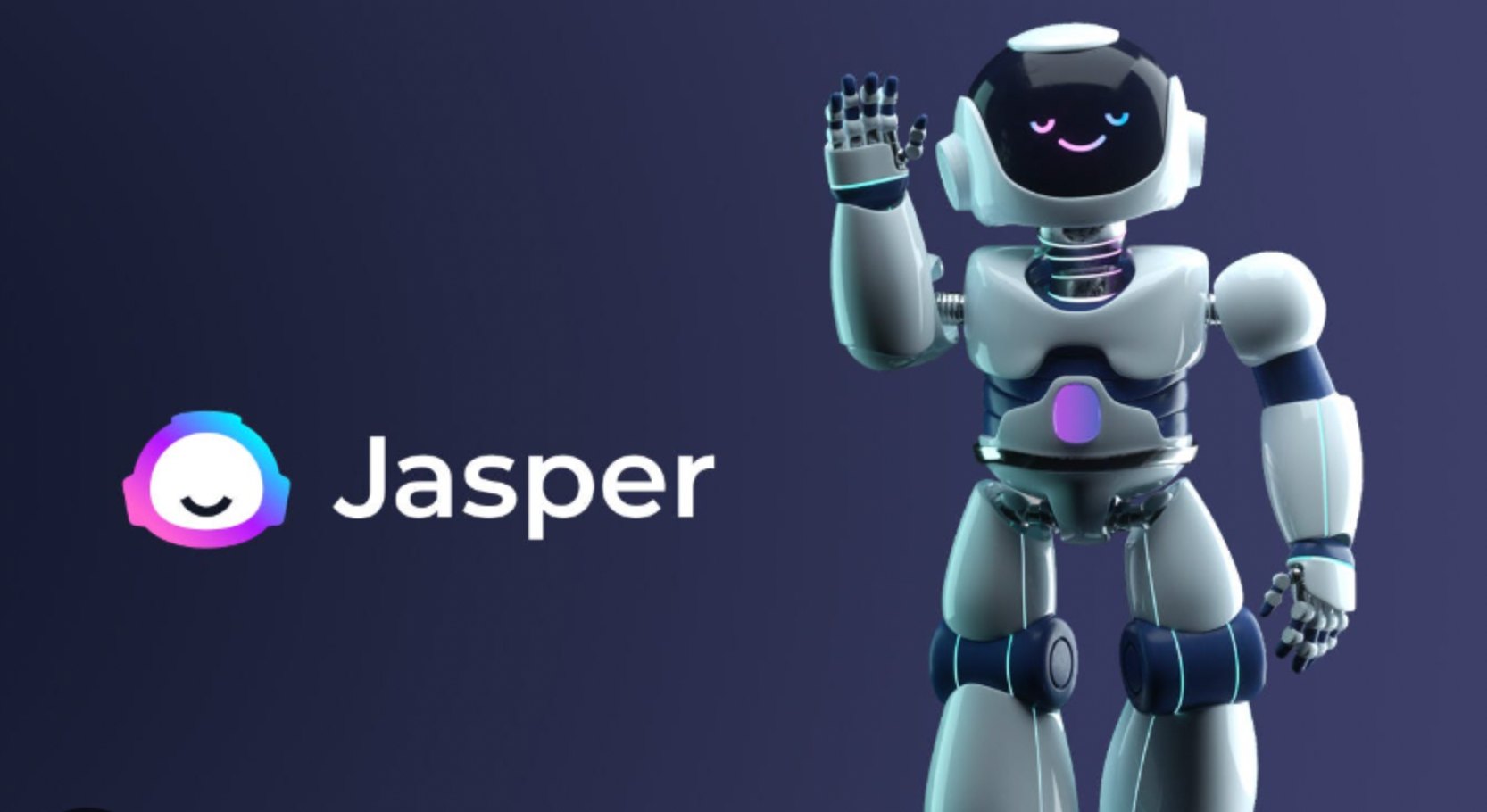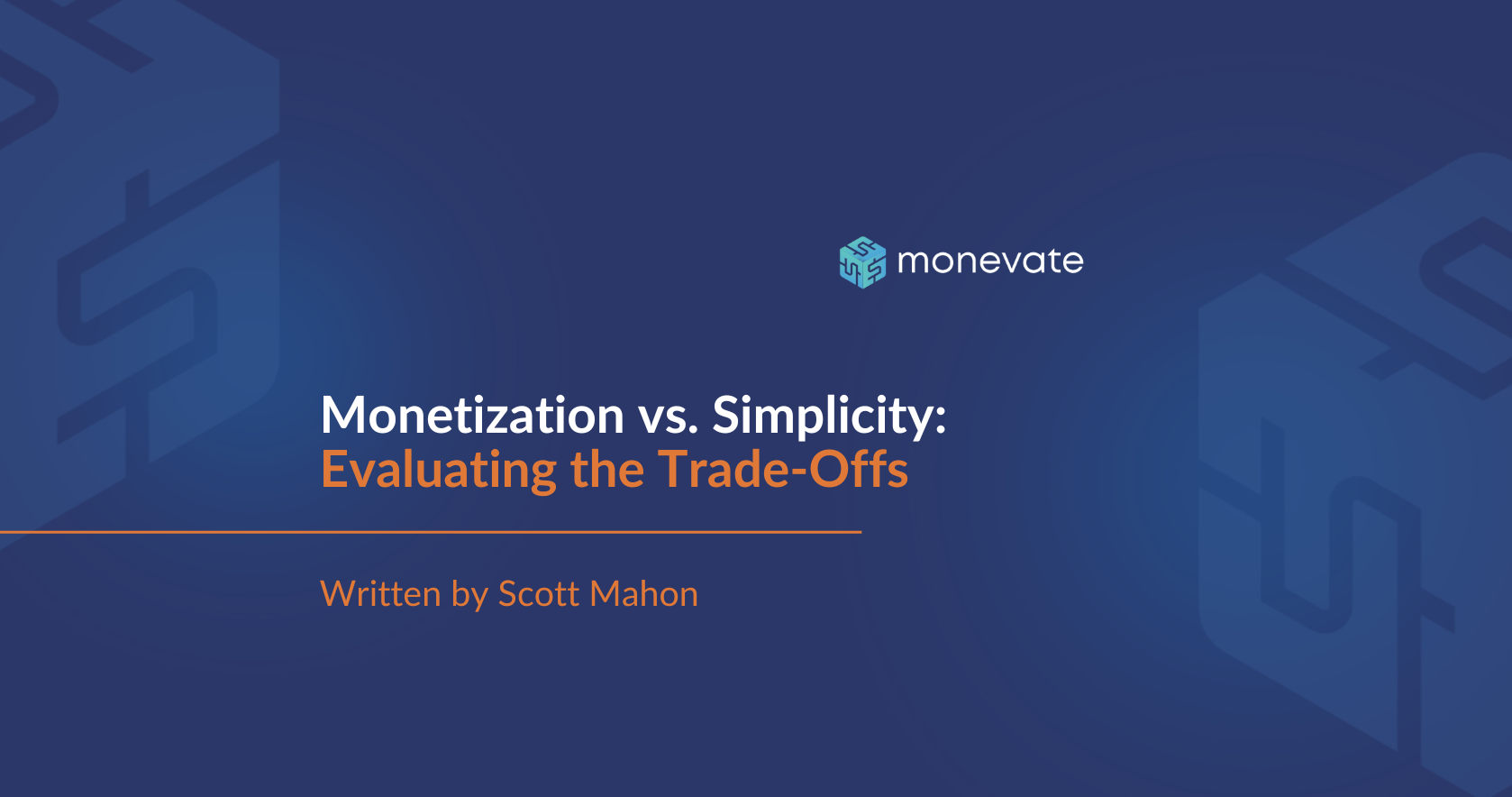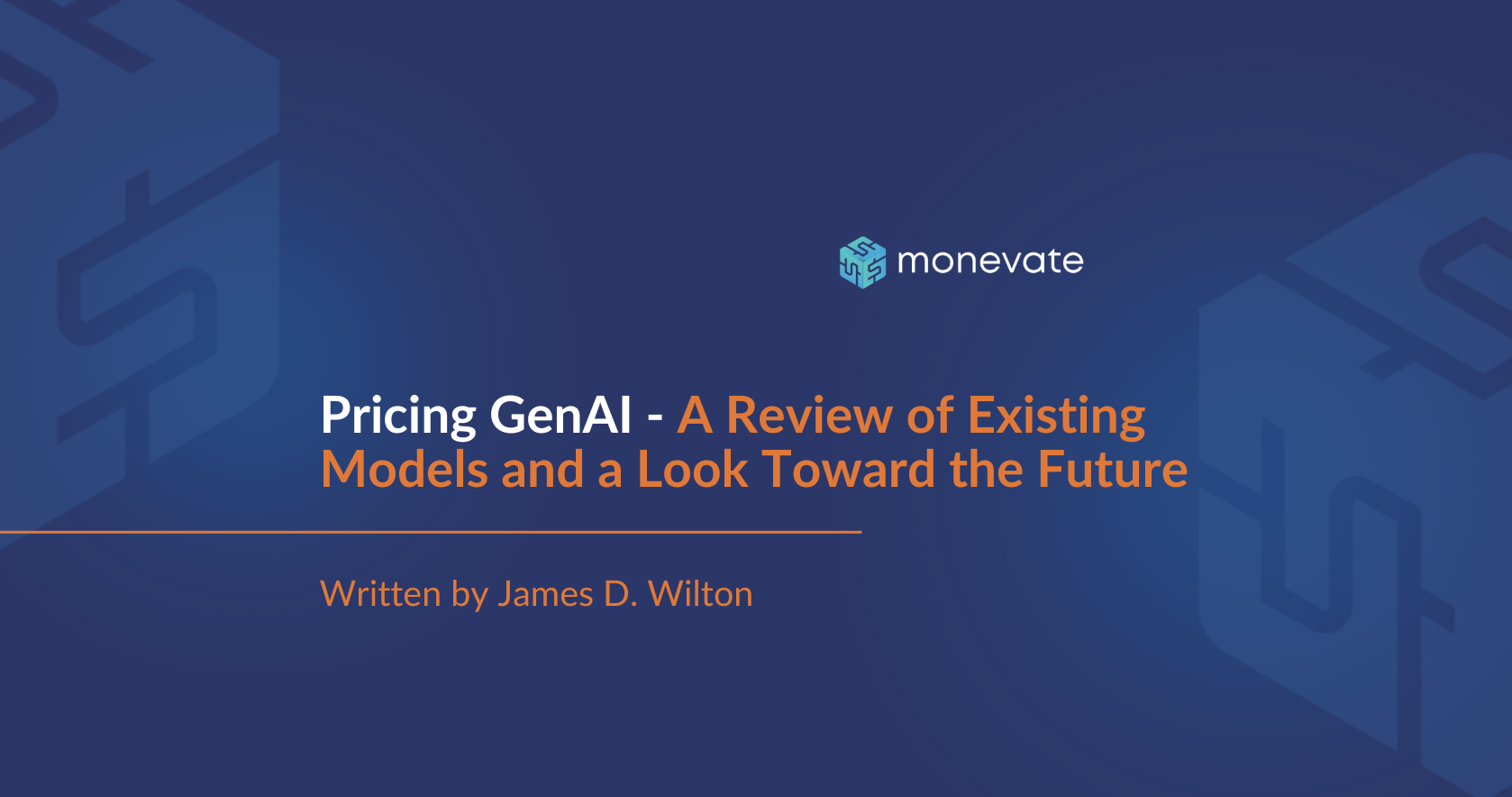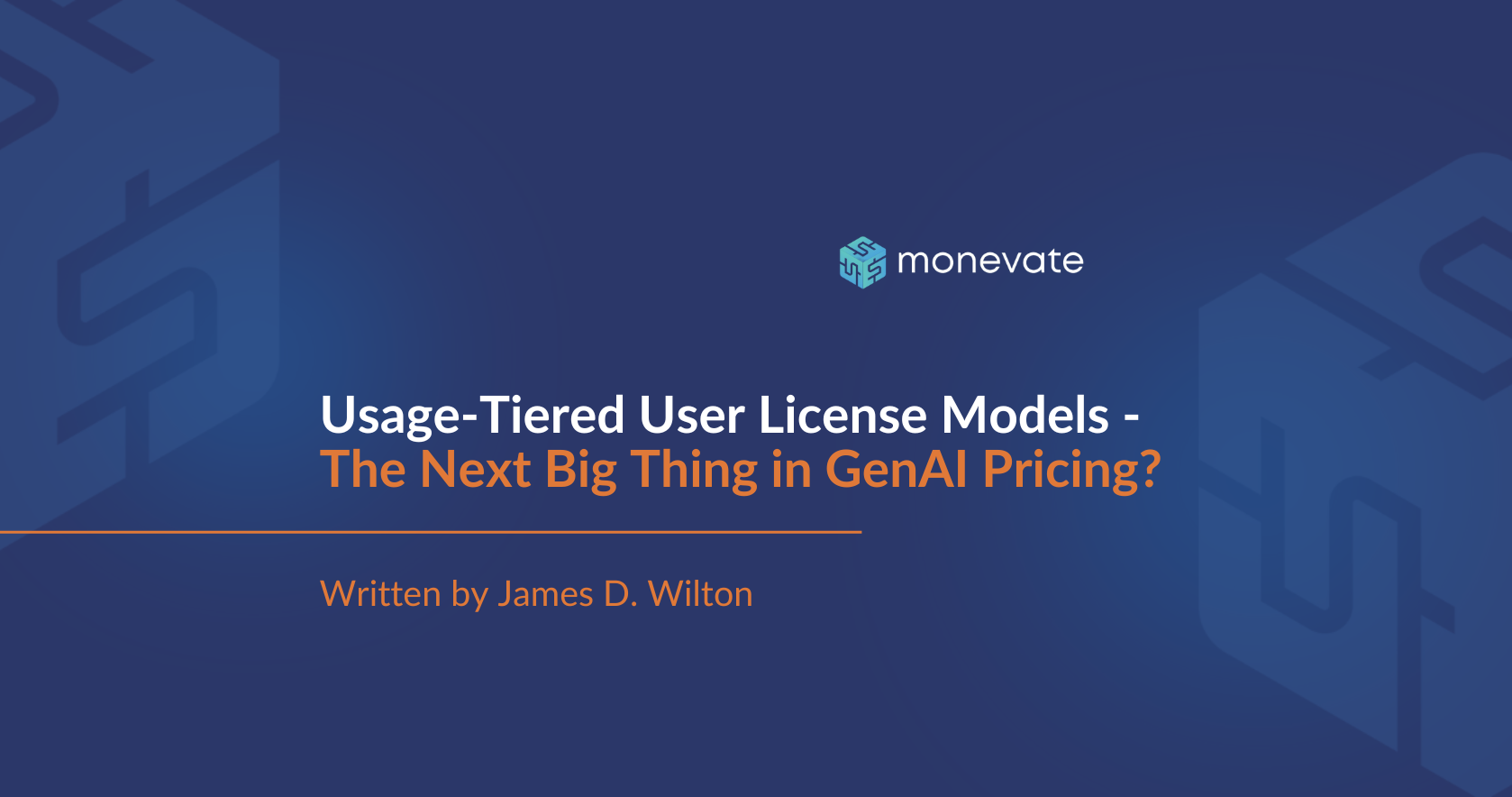GenAI Startups Must Innovate Their Pricing Models to Continue Their Growth
While GenAI remains the hotbed of innovation in tech, the level of innovation is not as high for AI’s pricing strategies, with most front-end UI startups continuing to opt for per user models, and foundation models sticking with usage. Adam Ahmed argues that the right answer may lie in hybrid models.
GenAI continues to be the hottest topic in SaaS – garnering endless media buzz and eye-popping funding rounds. That said, the space is not without its problems. Gartner recently predicted that 30% of generative AI projects will be abandoned due to unclear business value, poor data, high costs, or lack of risk controls. Upfront costs in this field can range from $100K to $20M, excluding recurring expenses. Without thoughtful, well-designed business models these businesses—particularly startups—are likely to find it challenging to scale longer term.
The level of thought required to thrive, we would suggest, is not being displayed in the field of pricing. Once again, we find another emerging technology being predominately priced using seats. Seat-based pricing has been the norm in SaaS since the beginning of its time, and while it can be the right pricing system for a business, it is overused. Its ubiquity is self-sustaining – customers are familiar with seats, which makes per seat pricing acceptable, and so it continues to be the default. Plus, user counts are highly predictable, which makes it easy for buyers to budget.
This method of pricing has naturally leaked into the GenAI space, which can be seen through front-end user applications such as ChatGPT charging $20 per user per month. Monevate research in this space shows that more than 50% of GenAI startups, which are usually front-end user applications, use a version of seat-based pricing.
With ChatGPT driving most of the $1.6B revenue figure for OpenAI, the application has clearly thrived under the seat-based pricing structure. The issue with this method of pricing isn't with these GenAI giants, but with smaller startups trying to follow market leaders and adopt this structure.
While seat-based pricing may work for some, it should not be the default for all startups in this emerging market.
Issues With Seat Based Pricing
Value alignment and growth orientation, arguably the two most important criteria of a pricing metric for startup companies, are not present in the seat-based models for front-end AI products. In fact, the enormous growth of usage-based and hybrid models for SaaS products over recent years has been driven by businesses seeking more value linked and growth-oriented price architectures.
Example: Jasper

To illustrate these issues, consider the example of Jasper, an AI-powered writing tool which helps users easily create content such as blog posts and product descriptions. It currently charges $39-$59 per user per month, allowing customers to produce an unlimited amount of AI-generated content.
- Weak Value- and Cost-Alignment: The implicit assumption in setting a flat price per user is that the value comes from a user being able to create content, not in how much content is created. However, this means that a user who uses the product only once or twice a month is paying the same price (higher than a subscription to Microsoft 365) as someone who is generating hundreds of queries every day. It’s hard to believe that the value is the same for these two users, and it likely presents a significant barrier to adoption for customers who don’t feel sure their usage will be high. Moreover, the costs of serving these two customers be markedly different – a major issue given the high costs involved in GenAI – meaning that margins may reduce (or even become negative) as usage increases.
- Limited Growth Orientation: Tying your price to a metric that naturally grows allows you to increase customer revenues over time. It’s not a given that the number of users will grow. In fact, companies often leverage GenAI applications to enhance productivity with fewer employees (resulting in fewer users). This would mean that startups may start to see their revenue decline in a seat-based structure. The usage from those fewer users may grow, but this is not being monetized. Let’s say a user generates 50% more descriptions in April, not only will the margins of Jasper be negatively impacted, but there will be no growth in NRR (net revenue retention) associated with this change.
“Due to the nature of AI eventually replacing human labor, a per-user pricing model might be counter-effective as the number of users will get reduced over time. This presents a disruptive opportunity for the second wave of AI apps.” – Kyle Poyar, OpenView
Why seats work for ChatGPT
So why is seat-based pricing effective for larger applications such as ChatGPT?
The answer lies in their development stage.
Unlike startups, OpenAI and similar companies are mature entities within their industry. This maturity allows them to adopt a business model where, despite a substantial number of users potentially creating losses due to excessive usage, the overall user base remains profitable. Furthermore, these companies bolster their growth through revenue generated from foundation model APIs that leverage a usage-based structure. In contrast, startups often depend entirely on rapid growth for success, making the financial stability and diverse revenue streams of mature companies like OpenAI less attainable in earlier stages.
Everyone loves a deal.
Consumers are heavily influenced by promotions, but B2B buyers are typically less so. As PLG pricing strategies in B2B often draw inspiration from consumer strategies, we often see an over-adoption of promotions and discounts that cause a lot of unnecessary value leakage.
The first mistake is to over-promote your product.
Promotions can drive sales volume, and if used sparingly, can generate revenue you wouldn’t otherwise have accessed. Price sensitive customers will only buy during the promotional period whereas price-insensitive customers won’t have the patience to wait. You should avoid giving the perception that your product is “almost always on sale”.
Price insensitive customers likely won’t wait six months for a promotion, but they might be inclined to wait a week or two if they’re pretty sure a promotion will come around, meaning your higher willingness-to-pay customers won’t pay the high prices they otherwise would have. Plus, being “always on sale” can signal lower quality, which might decrease your sales volume in the long term.
Similarly, it’s common for PLG players to discount annual contracts rather than month-to-month contracts, since that usually results in less churn, and (in some cases, depending on your billing) a full year’s revenue up front, which is helpful for cash flow. However, you should only be discounting at levels that make sense given the benefits you receive from the annual contract. If you don’t need the cash up front, and your annual churn rate on monthly contracts is not significantly higher than that of annual contracts, then it does not make sense to discount the annual contract by 20%! Bigger impacts should warrant bigger discounts.
A move to usage-based pricing?
So, if user-based pricing is not the right move for GenAI startups, what is the alternative? We’ve already spoken about the fact that usage drives value, so usage-based pricing is the next obvious option to consider. In most cases, companies developing a back-end foundation model - the invisible workhorses powering the AI features you interact with, such as GPT-4o by OpenAI, Stable Diffusion by Stability AI, Llama 3.1 by Meta, and BERT - have adopted usage-based pricing strategy using queries or tokens as the metric. This is effective for a few reasons:
- Value Alignment: Users generally receive more value from a back-end model as they increase their usage. While this isn’t always the case (such as with bad requests), usage-based metrics such as queries can effectively serve as an approximation for the value received.
- Cost Coverage: Aligning price with usage allows companies to protect their profit margins by ensuring the computing costs associated with each request are covered by the pricing model.
- Growth Orientation: Customers will pay more as they increase their usage over time, creating a strong opportunity to grow NRR (Net Recurring Revenue).
The pitfalls with usage-based pricing
However, as we’ve highlighted in a previous article on usage-based pricing (and how it led to the failure of Indeed’s pricing strategy), there are a few pitfalls to this model:
- Unpredictability: A pricing model that is completely usage-based leaves customers with uncertainty around their cost which can hinder their purchasing decisions (unless of course, they can predict the precise number of queries they’ll be using over the next month).
- Tenuous Value Alignment: If the metric chosen for a usage-based pricing model doesn’t effectively scale with value then at some point customers won’t find the price they’re paying to be acceptable. More concerningly, customers may become outraged (as was the case with Indeed).
- Taxi-meter Effect: Customers tend to limit their usage when they know their costs are rising with each incremental use. As a result, a usage-based pricing model may lead customers to use a product less – despite wanting more value from it.
The Hybrid Solution for AI Pricing?
We find ourselves in a quandary where neither user-based nor usage-based pricing appears optimal for GenAI startups. Adoption is key, and they should prioritize acceptability and predictability, presenting challenges to usage-based approaches. However, they also require a pricing structure that is value-aligned and growth-oriented to capitalize on the value they’re delivering, and cost-oriented to protect their margins, rendering user-based pricing ineffective.
The answer might lie in hybrid models. We see considerable potential in a usage-tiered license model.
In such a model customers would pay a flat subscription fee per seat based on their usage tier, with lower usage commanding a lower price point. This model would therefore be able to attract customers to trail the product through a low entry price point, while also being able to monetize additional usage. Once usage crossed a threshold, the user would have to pay a higher price for the next usage tier. By eliminating the granularity of a “pay per drink” traditional usage-based structure, customers have more predictability on their price level and will be less incentivized to second guess every transaction, since the usage is less-directly tied to price (macro usage changes are monetized, but individual queries are not). It also improves acceptability and value alignment versus a pure usage-model - customers may not feel they get extra value for each incremental query, but most will agree that if their usage doubles, say, they get enough meaningful extra value to justify a higher price tier.
Determining the right pricing strategy is a crucial decision for GenAI startups. While seat and usage-based pricing are most prevalent within the GenAI space, unfit implementation of these models could inhibit business growth rather than facilitating it. We find that leveraging the benefits of seat and usage-based models through a usage-tiered seat license model could be the optimal solution, allowing for the benefits of usage-based pricing with the improved predictability and acceptability of the seat-based model.
--
If you're interested in learning more about GenAI pricing strategies, RSVP for our upcoming masterclass here.














